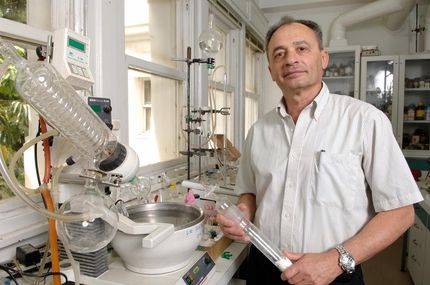2D network structure controlled by heat
European collaboration of scientists creates an H-bonded 2D network, in which changing temperature changes the 2D conformation.

2D nanostructure altered by change in temperature.
Davide Bonifazi has completed research both at the University of Namur, Brussels, and the University of Trieste, Italy and has collaborated with Meike Stöhr from the University of Basel, Switzerland and colleagues from the three universities. This collaboration reports the formation of an H-bonded porous hexagonal network which evolves into a close-packed rhombic pattern after thermally-induced trans-cis inversion of the conformation of the amidic groups.
‘We have shown using scanning tunnelling microscopy (STM) that 8-conjugated molecules bearing complementary H-bonding sites can self-organise into complex 2D porous networks on surfaces' Bonifazi explains. 'It is possible to thermally induce a phase transition (from a porous hexagonal to a rhombic close-packed 2D assembly) by exploiting conformational degrees of freedom.'
‘The need for highly organised materials at the molecular level has become increasingly apparent from basic science and applied technologies’ says Bonfazi. He explains that 'the current state of research in this field is still far from being a sophisticated and targeted "bottom-up" approach towards the fabrication of predictable supramolecular entities, usable in real-world applications.’
The group is planning to develop other networks which can be tuned in size and shape using external stimuli, by selecting appropriate spacing groups and recognition moieties.
Original article: Matena et al.; "Conformation-controlled networking of H-bonded assemblies on surfaces"; Chem. Commun. 2009
Most read news
Topics
Organizations
Other news from the department science

Get the analytics and lab tech industry in your inbox
By submitting this form you agree that LUMITOS AG will send you the newsletter(s) selected above by email. Your data will not be passed on to third parties. Your data will be stored and processed in accordance with our data protection regulations. LUMITOS may contact you by email for the purpose of advertising or market and opinion surveys. You can revoke your consent at any time without giving reasons to LUMITOS AG, Ernst-Augustin-Str. 2, 12489 Berlin, Germany or by e-mail at revoke@lumitos.com with effect for the future. In addition, each email contains a link to unsubscribe from the corresponding newsletter.
Most read news
More news from our other portals
Last viewed contents
Sartorius Grows by Double Digits - Targets for 2020 Updated
First-ever blueprint of a minimal cell is more complex than expected - EMBL and CRG scientists reveal what a self-sufficient cell can't do without

Scientists realize quantum simulation of the Unruh effect

Highest-resolution view of subcellular, single-molecule, spatial biology - Resolve Biosciences Secures $71 Million Series B Financing

New method developed for investigating the internal structure of atoms - Previously unknown properties of the element samarium revealed

Opening the Way to Mobile Olfaction with Nanomechanical Sensors





















































